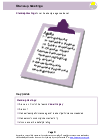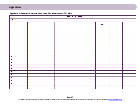Lean visual managagement: a guide for Highways England supply chain
Highways England encourages suppliers to use a "Lean" approach within their organisations to improve efficiency.
Highways England looks for evidence of use of Lean techniques when assessing suppliers. You should use this guide if you are a part of the Highways England supply chain or member of the highways industry and have a basic understanding of Lean principles. It will give you practical suggestions on what to do and consider when implementing Lean visual management for your projects.
Lean visual management is a way of working together to achieve clear shared goals. It can:
- help with problem solving
- encourage continuous improvement
- measure progress and track performance – performance information can be used to validate Highways England’s Motivating Success Toolkit submissions
- improve communication
- encourage teamwork and collaboration
- provide a forum for staff to raise issues
…implementing Lean visual management on the A421 project improved coordination within the team and with the surfacing subcontractor… Balfour Beatty, A421 Improvements: M1 J13 to Bedford
Highways England uses Lean principles to manage our road network to:
- increase effectiveness
- achieve more for less
- be an intelligent client
- reduce waste
We encourage our supply chain to use a Lean approach as part of our selection process. In Lean visual management you keep staff up to date and on track through use of:
- primary visual displays
- stand up meetings
- continuous performance improvement
Set the right environment
Lean visual management relies on teams working together to achieve clear shared goals. It works best when leadership encourages and demonstrates working together and where there is a designated area available where teams can come together. Ideally you should have a Lean practitioner act as a facilitator. This will help to keep meetings concise and focused
To get the most of Lean techniques you need to
- clearly define your goals and criteria for success
- set incentives that reward improvements to the overall outcome
- embrace transparency
- be willing to jump in, contribute and learn by participation
- be willing to be honest, constructive and direct
- be commited to learn
Primary visual display
A visual display provides a central point to display up-to-date, team-specific information. This will be used in stand up meetings and for team interaction. This display is different from a notice board, which provides only passive, one-way information. The team will regular update their display so it becomes a focal point for team interaction and improvement activity.
This display will cover information about:
- people – who is on site, schedules, important dates, issues, hazards/risks
- performance – average response times, cost and time forecasts, accident frequencies etc
- continuous improvement
The display must be positioned close to the team to be of benefit. This also creates a sense of ownership and allows for regular updates. In a construction environment you may use an existing meeting point, site canteen or other location where the team regular meets before/after they go to work.
Displays should be created by the team, for the team. The display must be accurate and relevant to be of benefit, so must be vigorously maintained. Nominate someone to be responsible for this.
Where shift changes occur, handover notes on the visual display are an ideal way to update the incoming shift. Notes may include:
- progress made
- changes to situation on site
- potential safety issues
Typically, wall-mounted pin boards are used in combination with magnetic or dry wipe boards. These show dynamic information updated daily and reports updated on a weekly or monthly basis.
Dynamic information may include:
- safety issues
- weather forecasts
- site attendance
- contact details
- activity schedules
- traffic management arrangements
- shift handover notes
- news
- reminders
Reports may include:
- health and safety information
- programme/cost information
- non-conformance reports
- contractor performance indicators
- continuous improvement activity
- lessons learned
Performance measures
It’s important to pick performance measures that:
- are important to the customer and easy to understand
- the team relate to and will gain satisfaction from working towards
- allow improvements to be tracked and captured easily
- will have data available to allow regular updates
Performance information that might be used to develop measures include:
- product: percentage delivery within target date
- service: average communication response time; journey time reliability; value opportunities and decision register confirmed savings
- “right first time”: average number of non conformance reports
- cost: actual cost against cost forecast
- time: actual time against time forecast
- safety: all accident frequency rate
Stand up meetings
Stand up meetings are regulatory, mandatory meetings held in front of a team’s visual display. These should be:
- attended by all team members
- kept brief (ideally 10-15 mins long)
- held at a regular time, ideally daily – if this is not feasible, longer meetings can be held less frequently
- follow a set agenda
They provide a forum to:
- focus on the issues of the day
- plan, assign and distribute the day’s workload
- discuss progress and improvement
- review performance measures
- discuss areas of under performance
- suggest improvements
- identify obstacles
One way to do this is for each team member to take turns in providing a progress update to the rest of the team. Updates should be brief and cover:
- what did I do yesterday – did I meet my commitments?
- what am I doing today – what can I commit to?
- what obstacles are preventing me from making progress and meeting my commitments?
It’s important that these meetings stick to the agenda and stay brief. More detailed discussions should take place separately so as not to interrupt the flow of the stand up meeting.
Stand up meetings:
- bring the team together, facilitating teamwork
- provide every member of the team with the opportunity to contribute
- provide every member of the team with same clear picture of what is happening
- highlight potential issues
- focus each member of the team on productivity and performance measures
Continuous improvement
Over time, continuous small improvements will result in significant improvements in performance. It is important to capture, record and evaluate practical suggestions for improvement. Suggestions should tackle areas of static or low performance, as identified by the team.
Once a suggestion has been implemented you should evaluate the result:
- was the suggestion successful and if not, why not?
- what was the result of implementing the suggestion?
- did performance increase? If so, by how much?
- did performance increase in areas other than those expected? Why?
Be sure to capture and communicate any lessons learned so that others can benefit from your work and implement similar suggestions if relevant.
You can experiment with different ways of capturing suggestions and see what works for you. Focus on simple, low tech, practical solutions that don’t need input from senior management. The two most common approaches are:
Concern, cause and countermeasure (3C)
“Concern, cause and countermeasure” or 3C is a simple table-based approach to capturing improvement suggestions. View an example of a 3C table.(LINK)
With this approach, suggestions arise from continuous review of progress. The team leader will log senior management concerns or off target performance on a 3C form, with input from their team. The form usually records:
- date raised
- the person who raised the issue
- a reference number for the issue so it can be tracked
- a brief description of the issue
- perceived cause of the issue eg office untidiness resulting in higher slip/trip rate
- agreed countermeasures
- the person responsible for implementing the counter measures
- status of implementation of counter measures
- results of implementation, including:
- result of implementing the counter measure
- performance increase – including in areas where no increase was anticipated
- was the countermeasure successful – if not, why not?
- lessons learned and how these were communicated
Four folder approach (4FA)
The four folder approach identifies and captures:
- ideas that fall below the radar in other organisation wide initiatives
- provide team members with an opportunity to influence the way they work
- small changes that can help to eliminate waste at source
The four folders contain:
- blank suggestion forms
- submitted suggestion forms
- instigated suggestion forms
- completed suggestion forms
Submitted suggestions can be reviewed at stand up meetings. The team supervisor can review them ahead of the meeting depending on the number submitted.
When a suggestion is submitted, team supervisors should:
- agree to undertake the suggestion themselves
- ask for a volunteer or nominate a member of the team to take forward the suggestion
- submit the suggestion to senior management if the team agree that the suggestion is “too big” to be taken on by the team alone
- agree with the team that the suggestion isn’t feasible to implement
If a suggestion is taken forward it is moved to the Instigation folder. Once the suggestion has been implemented and the results recorded, it can be moved to the Completed folder.
Scaling Lean visual management
Lean visual management is based around the structure of teams – a group of 6-10 indiviudals working in close proximity and share goals and objectives. Consider what might constitute a team for your own working purposes.
For example, larger or more complex work packages may require your department or wider teams to be broken into smaller single-discipline teams for the purposes of Lean visual management. You’d set up one visual display per team, displaying project information relevant to that team.
Team supervisors would still facilitate team meetings but would also attend meetings with other team supervisors to ensure clear cross-team communication. These meetings may require a visual display that provides information pertinent to senior staff. Teams should be encouraged to highlight issues that could affect other teams/colleagues/stakeholders so that these can be reported upwards.
Implementing Lean visual management
To implement Lean visual management you must first decide on appropriate performance measures for your team. This will allow your team to determine a baseline by which they can measure their improvement.
Teams can then begin their visual display, choosing to show the information that will best inform the team and support their performance improvement activity.
Once the visual display is in place, teams can begin their regular stand-up meetings. Over time teams will become more efficient during their stand up meetings, spending less time on individual progress reports and more time on performance measures and improvement activity.
As teams get used to Lean visual management techniques they should periodically review their performance against the original baseline to see what has been achieved to date.
Overcome concerns
When implementing any technique you may come across concerns or objections. Here are a few popular issues raised.
Lean won’t work here
The idea that Lean is only suited to manufacturing processes is a common misconception. Since its inception, Lean methodology has been successfully adopted across a wide range of industries including aerospace, engineering, finance, research and development, and marketing.
Lean is just a fad
Lean is not a new concept, but one which has been around since the early part of the 20th century. Many of the tools that are associated with modern Lean techniques were developed in the Japanese automotive industry at the end of the Second World War. Since then, Lean methodology has proven itself around the world.
I can’t work any harder/faster
Lean isn’t about increasing the pace of work. It is about increasing productivity by establishing ways in which teams can work more efficiently, both individually and collectively.
Lean visual management can be used on its own but is enhanced when using the Collaborative Planning System.

